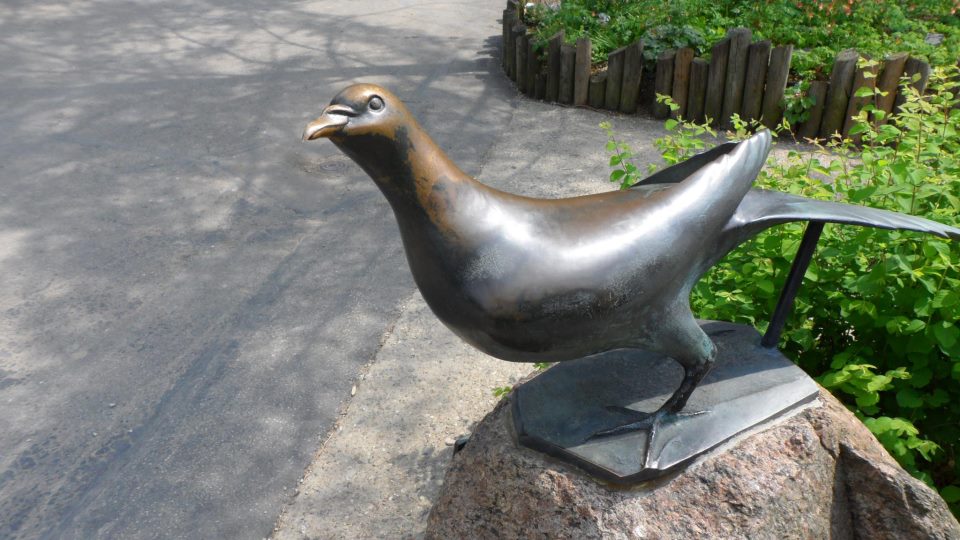 I’ll always be interested in anything to do with the Passenger Pigeon – the formerly most abundant species on Earth but which was driven to extinction, finally, on 1 September 1914.
I’ll always be interested in anything to do with the Passenger Pigeon – the formerly most abundant species on Earth but which was driven to extinction, finally, on 1 September 1914.
A new paper in Science suggests that Passenger Pigeons had a very low genetic diversity. the authors describe this as surprising but I’m not sure it is (although it is interesting).
I know little about genetics, and most of what I think I know is badly-remembered and out of date, but I suspect that the bunch of geneticists who were surprised by this finding hadn’t given quite enough thought to the ecology of the bird (just as we ecologists don’t give enough thought to genetics, I guess).
According to me, but not just me, the Passenger Pigeon was a nomadic species which travelled the eastern North American deciduous forests in search of beech mast, acorns and chestnuts. A Passenger Pigeon born one year in, say, Vermont (in a year when Vermont trees produced a lot of nuts (in fact, in the spring after they did just that in the autumn (fall for American readers))) might nest for the first time the next year in Minnesota or Wisconsin. And it may have been reared on beech mast but rear its own nestling on acorns.
So, in my understanding of the bird it was not, remotely, tied to a geographical area either for breeding or for wintering – it was nomadic on a grand scale. And although you might regard feeding on tree seeds as a specialised diet, they weren’t the same species of tree each year.
Under these circumstances, a species that nested, and quite probably wintered, in different parts of its range each year, and fed on different food sources each year depending on what was abundant, there was little scope for natural selection to favour certain traits above others. And since the bird nested in vast colonies and flew in vast flocks and wintered in vast winter roosts, large chunks of the population were subject to the same selection pressures each year.
It’s not like your average Wren which lives in one place and potentially lives under slightly different conditions from those of other Wrens. In fact, come to think of it, that’s quite a handy comparison. If millions of nomadic Wrens turned up on St Kilda, Shetland, Fair Isle and the Outer Hebrides every few years then there’d be little scope for sub-speciation of Troglodytes.
So that would be my, ecological, take on these, genetic, findings. But everything about Passenger Pigeons is interesting – it’s just a shame that they aren’t around for us to study them these days.

[registration_form]
I cannot access the paper in Science via your link …
has ringing on St Kllda proven the presence of migrant / passage wrens – of course it always poss that the occasional bird remains & genetic exchange occurs – this happens in eg euro spoonbill & w African balsacii spoonbill in Mauratania proven by colour ringing bws CrB
Summary on ScienceDaily here: https://www.sciencedaily.com/releases/2017/11/171116142036.htm
yes, we wish:
https://annawright.co.uk/hi-guys-i-m-back-1506.html
That makes sense. How else to explain a population of 100’s of millions vanishing in just a few decades? – not enough genetic diversity for the chance of, at the very least, some adaptation to slow down such a precipitous rate of decline.
I think you’re right that Passenger Pigeon (I’m going to say PP from now on!) ecology might not impose many strong selection pressures, Mark, but you might have misunderstood how that relates to genetic diversity. High genetic diversity describes the existence of a wide range of variations on each trait, which might vary in their ‘fitness’ under different conditions. Natural selection acts to favour some traits over others, and increase their relative frequency in the population – sometimes this can result in the extinction of certain unfavourable traits. Therefore, natural selection acts to reduce genetic diversity (but in the process, to increase genetic ‘quality’, if such a thing exists). If a population has low genetic diversity, then there are few varieties for natural selection to ‘choose’ from in the face of changing or unfavourable conditions – making that population more vulnerable to extinction, if all variations on a certain trait are unfavourable.
The general thinking is that in a very large population that covers a very large geographic area (read: PP before their decline), especially one that moves around in the way you describe, natural selection will not have a strong hold. Occasionally a new trait may arise by chance, but they are unlikely to be lost in the way I describe above, so genetic diversity should be high. The fact that PP genetic diversity was low might give a clue to the dramatic nature of their decline – perhaps they were unable to evolve in any meaningful way to allow them to persist.
I’m not sure I understand the second part of what you are saying here. Surely if we are talking about one large, interconnected population then any new traits that are beneficial are likely to quickly spread and become widespread in the population. In contrast, if they hamper survival then they wont stand much of a chance and are likely to be lost because birds with that trait will be rapidly outcompeted. So we would expect low genetic diversity. If populations are not so connected then this process would not happen so quickly and you would expect genetic diversity to be greater (as well as the fact that separated populations are likely to be subject to different selection pressures).
Reading back, I don’t think I did a very good job of explaining this. Your interpretation is pretty much correct, but I think the paper is referring to what’s described as neutral genetic diversity: i.e. diversity of traits which vary in the population without conferring any advantages or disadvantages under current conditions (e.g. hair colour in humans). High neutral genetic diversity is a good thing to have (from the point of view of the population as a whole), because if the environment changes, the chances are higher that a genotype exists that can survive under the new conditions. For (an over-simplified) example, if the environment changed in such a way that only people with red hair could survive and reproduce, a population with a full range of hair colours might survive, whereas a population consisting entirely of brown-haired people would go extinct.
In a small population, neutral diversity decreases because traits can disappear by chance, through ‘genetic drift’, but this is much less likely to happen in a large population. For example, consider a population (A) of five people (one blonde, one black-haired, one dark-brown-haired, one light-brown-haired and one red-haired), and a second population (B) with 500 people in the same proportions. Assuming monogamy and all else being equal, the chances that the red-haired person will fail to reproduce (leading to the extinction of the genes for red hair) in population A are 1/5. The chances that ALL red-haired people in population B will fail to reproduce… I can’t calculate, but they’re much, much lower!
As the PP population was so large, you might expect that neutral genetic diversity would remain high, because the chance of a neutral trait being lost by chance from the entire population is miniscule, so it’s interesting that the authors of the Science paper found the opposite. If I’ve understood correctly, they suggest that because (as you’ve correctly said) the large population size allowed favourable traits to be unusually rapidly fixed, and unfavourable traits unusually rapidly eliminated (leading to low genetic diversity of non-neutral traits), neutral traits were more likely to be dragged along with the unfavourable traits to extinction (because genes are not entirely randomly mixed, but assort along a limited number of chromosomes, and natural selection picks the best set of chromosomes rather than the best set of genes). That would lead to lower neutral genetic diversity. At normal rates of evolution, neutral traits often have time to uncouple themselves from unfavourable traits through ‘recombination’, whereby two different versions of the same chromosome effectively swap some genes – but maybe evolution in the massive PP population operated too quickly for this random process to be effective.
Callum – many thanks.
I’m no geneticist, but I tend to think that the changes that led to the demise of the PP were so massive and so rapid that ‘genetic’ evolution would have struggled to keep up, whatever the initial level of diversity. Their only hope might have been some form of ‘cultural’ evolution (I’m thinking blue tits and milk bottles here) which might have enabled tem to change some aspects of their behaviour on time scales closer to those of the challenges they faced.
Does that mean humans are doomed?
When i read the news, it seems like that would be good news for everything else on the planet. Then i go for a walk.
If only Batman had read your book.